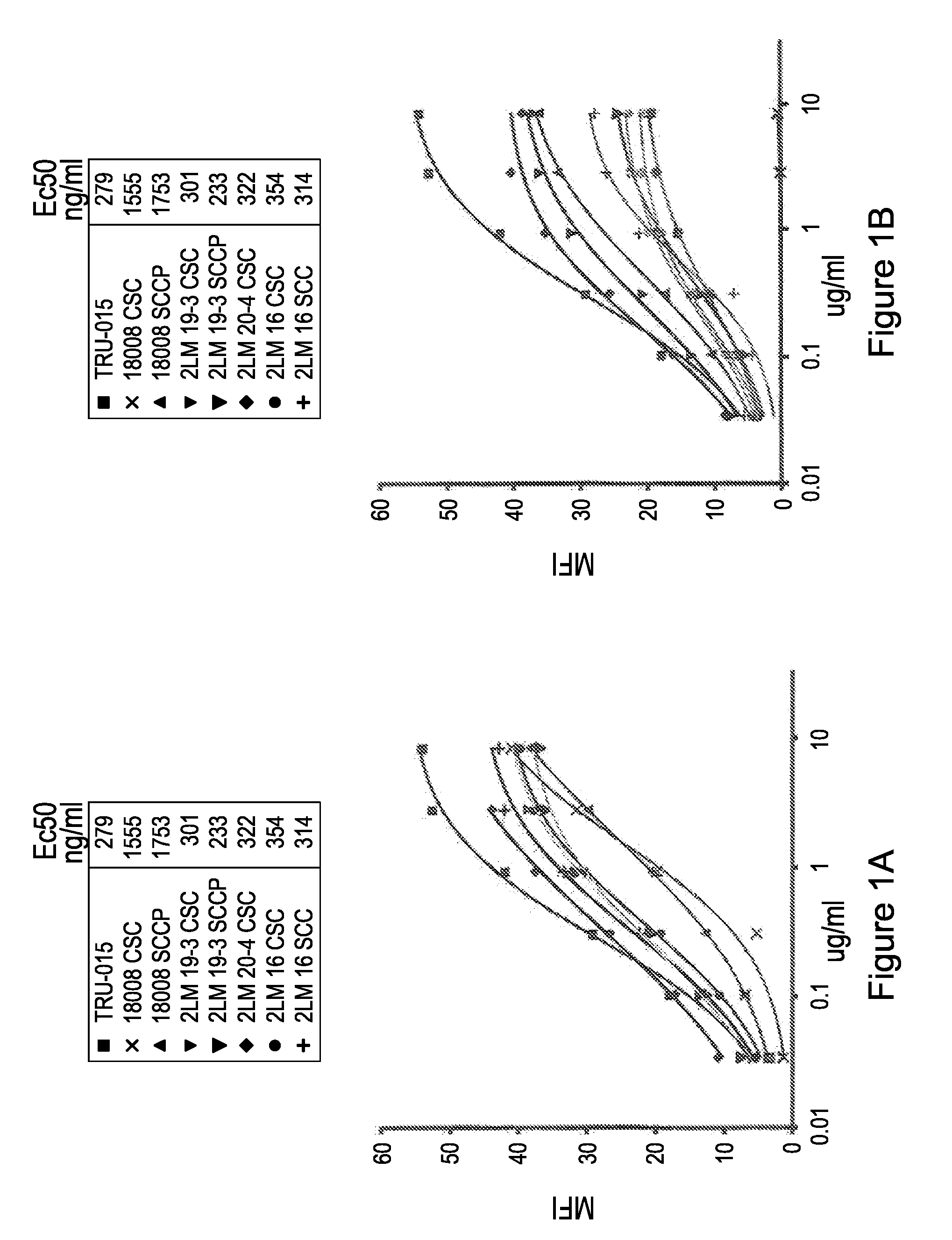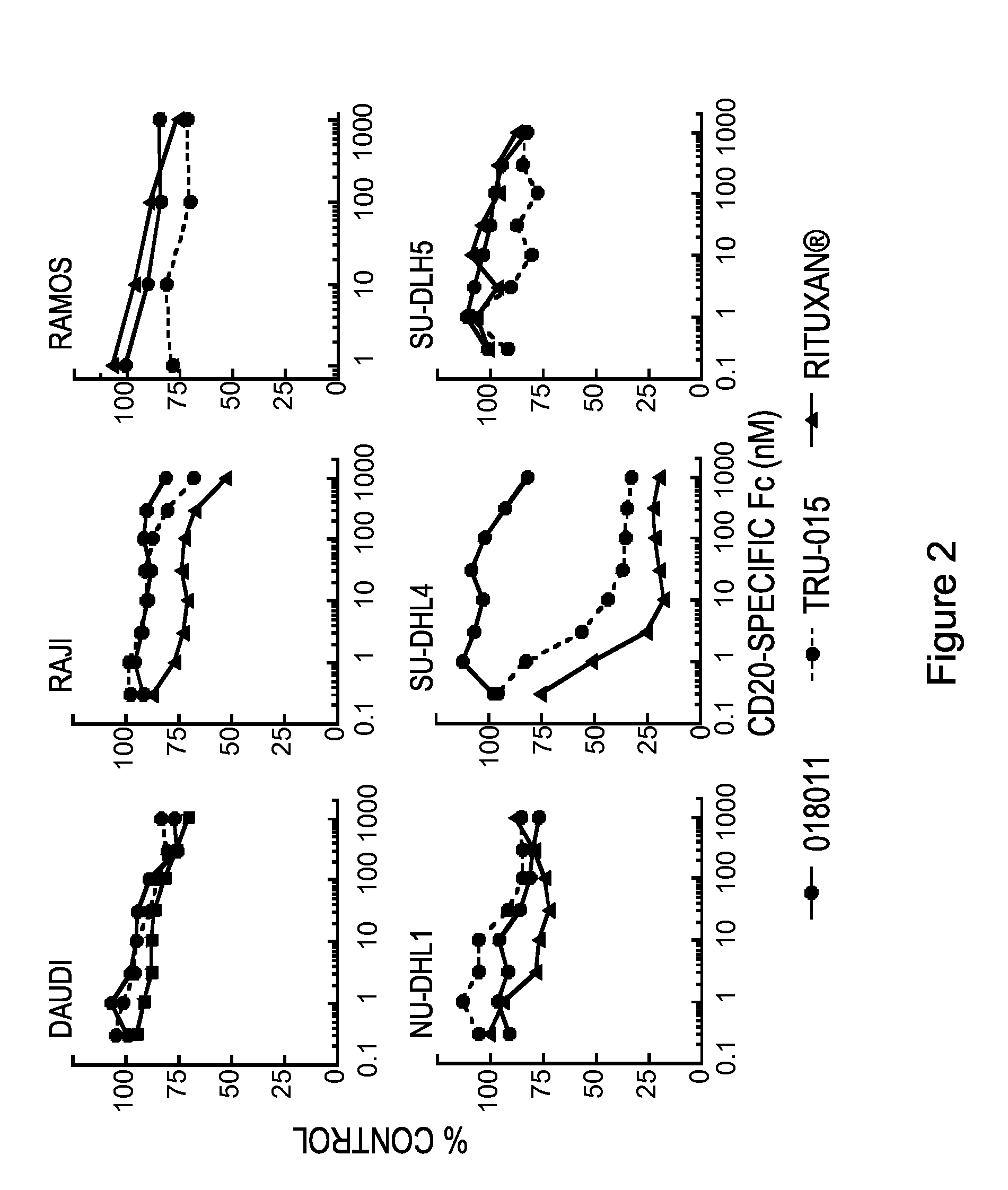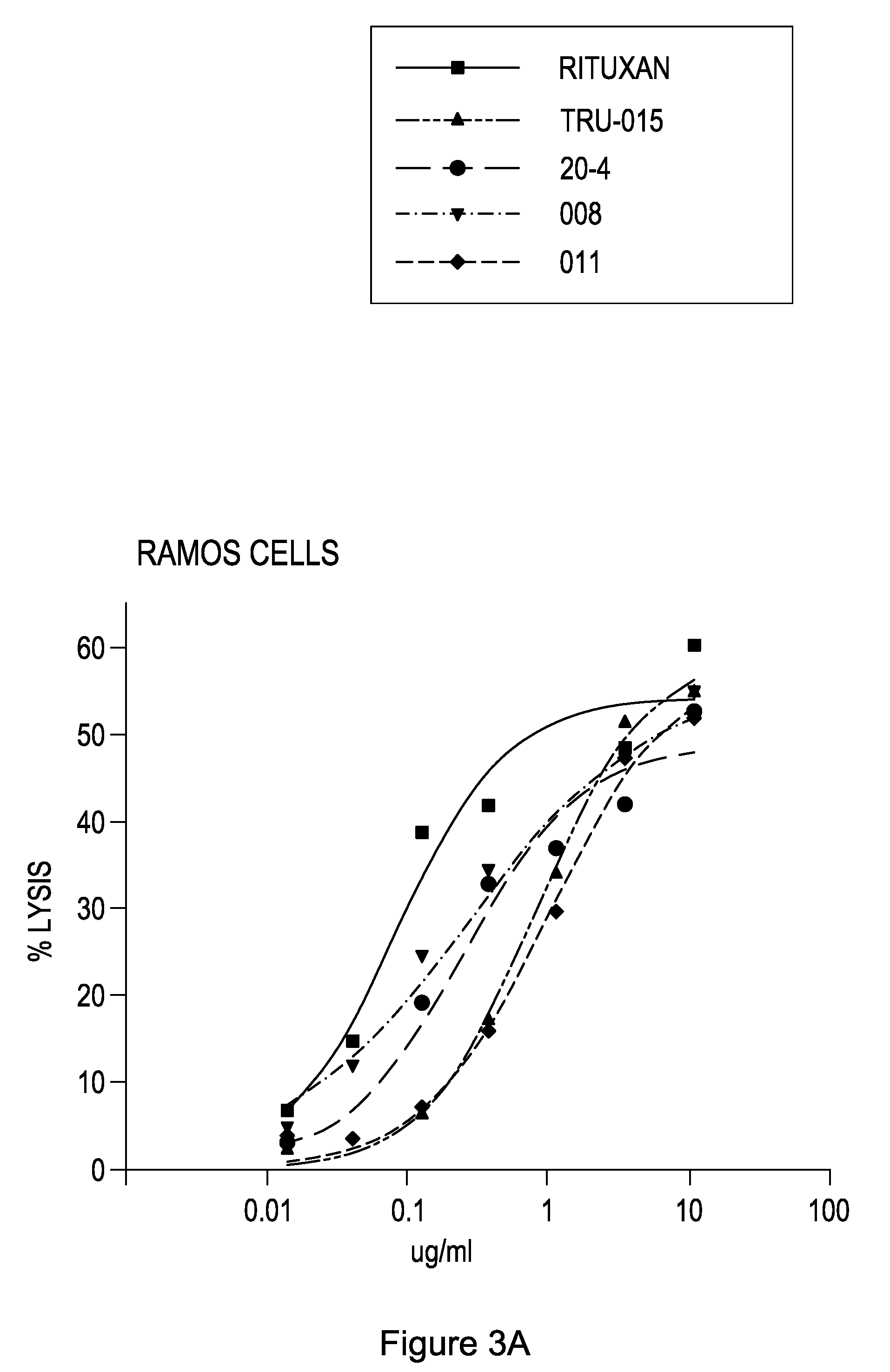Anti-cd20 therapeutic compositions and methods
a technology of anti-cd20 and composition, which is applied in the field of anti-cd20 therapeutic compositions and cd20specific binding molecules, can solve the problems of human immune system lymphocytes and go awry, and achieve the effects of reducing the progression and effect of disseminated lymphoma, and reducing the growth of b cell lymphoma tumors
- Summary
- Abstract
- Description
- Claims
- Application Information
AI Technical Summary
Benefits of technology
Problems solved by technology
Method used
Image
Examples
example 1
Binding of Anti-CD20 SMIPs to Primary B cells
[0181]Primary Human B Cells
[0182]To determine the binding of anti-CD20 SMIPs to primary B cells, we isolated primary B cells from buffy coats using negative selection B cell isolation kit (StemCell Technologies). We incubated the harvested cells with varying concentrations of anti-CD20
[0183]SMIP for 30 minutes on ice. Cells were then washed in 0.5% BSA / PBS, and stained with anti-human IgG-PE for 30 minutes and analyzed by flow cytometry (MFI) on FacsCalibur.
[0184]As demonstrated in FIG. 1, all anti-CD20 SMIPs analyzed in this example (TRU-015, 018008 csc, 018008sccp, 2LM 19-3 csc, 2LM 19-3 sccp, 2LM 20-4 csc, 2LM 16 csc, 2LM 16 scc, 2LM 16 sccp, 2LM 20-4 sccp, 009csc, 009 scc, 009 sccp, 018011 csc, 018011 scc, 018011 sccp) had comparable binding affinities to CD20 on human B cells.
TABLE 2Binding on Primary B cells with P / S mutation SMIPSMFIMFIMFIMFI10 ug / ml1.1 ug / ml0.37 ug / ml0.12 ug / mlRituxan198.7Rituxan172.9Rituxan137.3Rituxan105.7TRU-01...
example 2
Complement Dependent Cytotoxicity Assay of Anti-CD20 SMIPs
[0188]Ramos Cells
[0189]To determine the level of complement dependent cytotoxicity (CDC) of the human anti-CD20 SMIPs, we incubated Ramos cells with anti-CD20 SMIPs in the presence of 10% human sera (Quidel) for 3.5 hours at 37° C. We assessed cell death by measuring LDH release from cells (Promega kit).
[0190]As shown in FIG. 3A, RITUXAN®, TRU-015, 2LM 20-4, 018008, and 018011 had comparable CDC activity against human Ramos B-cells.
TABLE 3CDC on Ramos cells with P / S mutation SMIPS% lysis% lysis% lysis% lysis10 ug / ml1.1 ug / ml0.37 ug / ml0.12 ug / ml2Lm 16 sccp p / s85.72Lm 19-3 sccp58.1Rituxan60.2Rituxan56.5009 sccp p / s83.018008 sccp57.118008 sccp47.918008 sccp32.2Rituxan82.5Rituxan57.12Lm 20-4 sccp45.42Lm 19-3 sccp30.52Lm 19-3 sccp p / s80.3TRU-01556.12Lm 19-3 sccp40.82Lm 20-4 sccp20.018008 sccp72.52Lm 20-4 sccp52.9TRU-01538.8TRU-01516.3TRU-01567.7009 sccp50.3009 sccp26.1009 sccp p / s11.42Lm 20-4 sccp p / s66.32Lm 20-4 sccp p / s28.3009 c...
example 3
Antibody Dependent Cytotoxicity (ADCC) Assays of Anti-CD20 SMIPs
[0203]We determined the level of antibody dependent cytotoxicity (ADCC) (also referred to as FcCC) of the anti-CD20 SMIPs using a number of different target cells.
[0204]BJAB Lymphoma Cells
[0205]In one experiment, we labeled BJAB lymphoma cells with 0.5 uM CFSE. Labeled cells were then incubated with anti-CD20 binders for 15 minutes, followed by the addition of activated PBMC (which were previously stimulated with IL-2 and IL-12 overnight). After 6 hours of incubation, we stained CFSE target cells (CFSE+) with PI and assessed cell death using flow cytometry.
[0206]As demonstrated in FIG. 5, RITUXAN®, TRU-015 and 2LM20-4 mediated comparable ADCC activity. Additional experiments using 51Cr labeled BJAB cells demonstrated ADCC activity of 018008 and 018011 (data not shown).
[0207]Ramos B-Cells and SU-DHL4
Preparation of Effector Cells
[0208]PBMNC were isolated by density-gradient centrifugation using (Lymphoprep™ Axis-Shield Po...
PUM
| Property | Measurement | Unit |
|---|---|---|
| concentrations | aaaaa | aaaaa |
| volumes | aaaaa | aaaaa |
| volumes | aaaaa | aaaaa |
Abstract
Description
Claims
Application Information
 Login to View More
Login to View More - R&D
- Intellectual Property
- Life Sciences
- Materials
- Tech Scout
- Unparalleled Data Quality
- Higher Quality Content
- 60% Fewer Hallucinations
Browse by: Latest US Patents, China's latest patents, Technical Efficacy Thesaurus, Application Domain, Technology Topic, Popular Technical Reports.
© 2025 PatSnap. All rights reserved.Legal|Privacy policy|Modern Slavery Act Transparency Statement|Sitemap|About US| Contact US: help@patsnap.com



